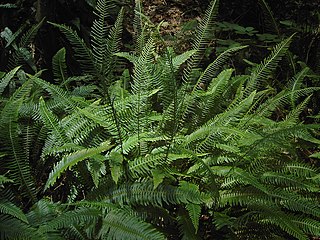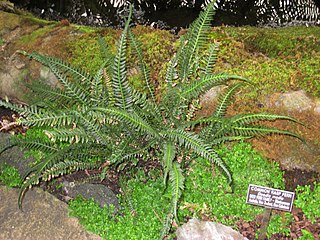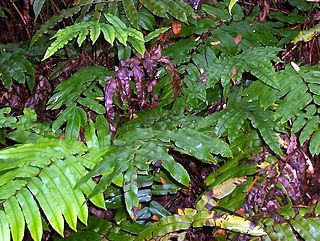
Dacrydium cupressinum, commonly known as rimu, is a large evergreen coniferous tree endemic to the forests of New Zealand. It is a member of the southern conifer group, the podocarps. The former name "red pine" has fallen out of common use.

A frond is a large, divided leaf. In both common usage and botanical nomenclature, the leaves of ferns are referred to as fronds and some botanists restrict the term to this group. Other botanists allow the term frond to also apply to the large leaves of cycads, as well as palms (Arecaceae) and various other flowering plants, such as mimosa or sumac. "Frond" is commonly used to identify a large, compound leaf, but if the term is used botanically to refer to the leaves of ferns and algae it may be applied to smaller and undivided leaves.

The order Cyatheales, which includes most tree ferns, is a taxonomic order of the fern class, Polypodiopsida. No clear morphological features characterize all of the Cyatheales, but DNA sequence data indicate the order is monophyletic. Some species in the Cyatheales have tree-like growth forms from a vertical rhizome, others have shorter or horizontal expanding rhizomes.

Nephrolepis exaltata, known as the sword fern or Boston fern, is a species of fern in the family Lomariopsidaceae. It is native to the Americas. This evergreen plant can reach as high as 40–90 centimetres (16–35 in), and in extreme cases up to 1.5 metres. It is also known as the Boston swordfern, wild Boston fern, Boston Blue Bell Fern, tuber ladder fern, or fishbone fern.

Onoclea is a genus of plants in the family Onocleaceae, native to moist habitats in eastern Asia and eastern North America. They are deciduous ferns with sterile fronds arising from creeping rhizomes in spring, dying down at first frost. Fertile fronds appear in late summer. Depending on the authority, the genus contains one to five species.

Blechnaceae is a family of ferns in the order Polypodiales, with a cosmopolitan distribution. Its status as a family and the number of genera included have both varied considerably. In the Pteridophyte Phylogeny Group classification of 2016, the family has 24 genera, and excludes genera placed in the separate family Onocleaceae. The family is divided into three subfamilies, including Blechnoideae s.s. Alternatively, the entire family may be treated as the subfamily Blechnoideae s.l. of a very broadly defined family Aspleniaceae, and include genera others place in Onocleaceae.

In botany, a rosette is a circular arrangement of leaves or of structures resembling leaves.

Alsophila australis, synonym Cyathea australis, also known as the rough tree fern, is a species of tree fern native to southeastern Queensland, New South Wales and southern Victoria in Australia, as well as Tasmania and Norfolk Island.

Blechnum, known as hard fern, is a genus of ferns in the family Blechnaceae, subfamily Blechnoideae, according to the Pteridophyte Phylogeny Group classification of 2016. Two very different circumscriptions of the genus are used by different authors. In the PPG I system, based on Gasper et al. (2016), Blechnum is one of 18 genera in the subfamily Blechnoideae, and has about 30 species. Other sources use a very broadly defined Blechnum s.l., including accepting only two other genera in the subfamily. The genus then has about 250 species. In the PPG I circumscription, the genus is mostly neotropical, with a few southern African species.

Struthiopteris spicant, syn. Blechnum spicant, is a species of fern in the family Blechnaceae, known by the common names hard-fern or deer fern. It is native to Europe, western Asia, northern Africa, and western North America. Like some other species in the family Blechnaceae, it has two types of leaves. The sterile leaves have flat, wavy-margined leaflets 5 to 8 millimeters wide, while the fertile leaves have much narrower leaflets, each with two thick rows of sori on the underside.

Cranfillia fluviatilis, synonym Blechnum fluviatile, is a fern known in the Māori language as kiwikiwi. A herbaceous plant, C. fluviatilis is a "hard fern" of the genus Cranfillia in the family Blechnaceae. It was identified by Patrick Brownsey in 1979. Other common names are star fern, creek fern, kawakawa and kiwakiwa.

Doodia media, also known as rasp fern, is a fern species in the family Blechnaceae. The species was formally described by botanist Robert Brown in 1810. Distribution of the species includes New Zealand's North Island and the upper part of the South Island. It is also found in Australia and Lord Howe Island.

Rumohra adiantiformis, the leather fern or leatherleaf fern, is a species of fern in the wood fern family Dryopteridaceae. It has a wide distribution, mainly in the tropical Southern Hemisphere.

Lomariocycas magellanica, synonym Blechnum magellanicum, costilla de vaca or palmilla, is a medium-sized fern native with a natural range from Talca at 35°S, to the Magallanes Region in Chile. It grows from sea level up to 2200 m.a.s.l. It grows also in the humid valleys of western Argentina close to the Chilean border.

Parablechnum wattsii, synonym Blechnum wattsii, is a common terrestrial fern growing in rainforest and open forest. It is often seen near creeks in much of south eastern Australia, including Victoria, Tasmania, South Australia, New South Wales and Queensland. The specific epithet wattsii honours William Walter Watts (1856-1920). Watts was considered an authority on mosses and ferns and has more than 30 species named for him. Common names by which the species may be called are hard water fern - from its stiff leathery fronds, leech fern - as forest workers often encounter leaches while working in clusters of these ferns, hard hill fern - from the fern's habit and habitat, and red cabbage fern - from the bronze-pink colour of the young fronds resembling cooked red cabbage.

Lomaria nuda, commonly known as the fishbone waterfern, is a fern that grows up to a metre tall, and is abundant in rainforest and eucalyptus forests in eastern Australia. The species is placed in the genus Lomaria in the Pteridophyte Phylogeny Group classification of 2016, but is often retained in genus Blechnum as Blechnum nudum.

Southern Afrotemperate Forest is a kind of tall, shady, multilayered indigenous South African forest. This is the main forest-type in the south-western part of South Africa, naturally extending from the Cape Peninsula in the west, as far as Port Elizabeth in the east. In this range, it usually occurs in small forest pockets, surrounded by fynbos vegetation.

Lomariocycas palmiformis, synonym Blechnum palmiforme, is a species of fern in the family Blechnaceae. It is endemic to the Tristan da Cunha group of islands. The species is a tree fern that can grow to 2 m in some sheltered areas. It resembles the form of a palm tree, but is not part of Arecaceae, the palm family.
Erythrophleum couminga is a species of leguminous tree in the genus Erythrophleum. It is endemic to the western coastal region of Madagascar, occurring in the Baie de Baly National Park. The bark is used in traditional medicine and the branches are used for fencing posts.

Lomariocycas is a genus of ferns in the family Blechnaceae, subfamily Blechnoideae, according to the Pteridophyte Phylogeny Group classification of 2016. The genus is accepted in a 2016 classification of the family Blechnaceae, but other sources sink it into a very broadly defined Blechnum, equivalent to the whole of the PPG I subfamily.



















